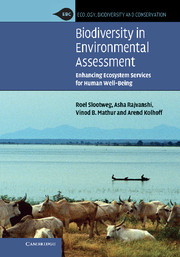Book contents
- Frontmatter
- Contents
- List of contributors
- Foreword
- Preface
- List of abbreviations
- Part I Setting the stage
- Part II Assessment tools
- 4 The impact assessment framework
- 5 Environmental assessment
- 6 Biodiversity in environmental impact assessment
- 7 Biodiversity-inclusive Strategic Environmental Assessment
- Part III Emerging issues
- Epilogue – Topics in need of further elaboration
- Annex: valuation of ecosystem services: influential cases
- References
- Index
6 - Biodiversity in environmental impact assessment
Published online by Cambridge University Press: 05 July 2014
- Frontmatter
- Contents
- List of contributors
- Foreword
- Preface
- List of abbreviations
- Part I Setting the stage
- Part II Assessment tools
- 4 The impact assessment framework
- 5 Environmental assessment
- 6 Biodiversity in environmental impact assessment
- 7 Biodiversity-inclusive Strategic Environmental Assessment
- Part III Emerging issues
- Epilogue – Topics in need of further elaboration
- Annex: valuation of ecosystem services: influential cases
- References
- Index
Summary
Introduction
As the importance of biodiversity for human well-being is increasingly brought to the forefront by scientific endeavours in the fields of natural sciences, resource economics, and conservation ecology, the need for better representation of biodiversity in the processes that steer development decisions has clearly emerged. Furthermore, outspoken stakeholders actively participating in impact assessment processes bring the importance of biodiversity to the forefront, contributing to the need for better representation of biodiversity. Environmental Impact Assessment (EIA) is one of few internationally recognised and often legally embedded instruments to predict the potential consequences of human activities. In recent years the impact assessment community realised that it was not doing well in defining the impact on biological diversity. Implicitly biodiversity was always considered to be part of impact assessment, but the tools to explicitly define biodiversity impacts were not enough. Box 6.1 provides some messages on biodiversity emerging from EIA practice.
This chapter provides extensive first-hand background documentation on the EIA guidelines adopted by the Convention on Biological Diversity (CBD, 2006) and further elaborates on the concepts behind the guidelines. Reference is made to Chapter 2 elaborating CBD objectives and explaining recent scientific developments in biodiversity science, Chapter 4 providing the conceptual framework underlying the EIA as well as SEA chapters, and Chapter 5 providing a general overview of recent thinking on EIA. In this chapter the screening and scoping stages of EIA are emphasised for two reasons. First, the need for an impact assessment study when a proposed activity has potential significant effects on biodiversity has to be defined by good screening criteria and procedures; second, the impact assessment study has to be carried out in such a manner that all relevant issues are properly dealt with, providing sufficient information for decision makers to come to a well-founded decision. Because scoping determines the quality of the terms of reference of the impact study, good scoping procedures and guidance on the scoping process are of fundamental importance.
- Type
- Chapter
- Information
- Biodiversity in Environmental AssessmentEnhancing Ecosystem Services for Human Well-Being, pp. 154 - 204Publisher: Cambridge University PressPrint publication year: 2009
- 3
- Cited by



